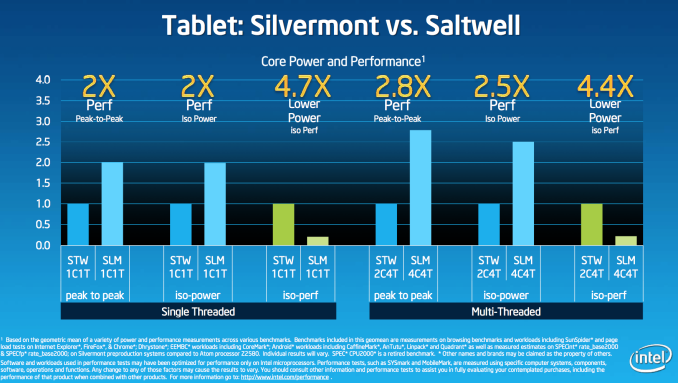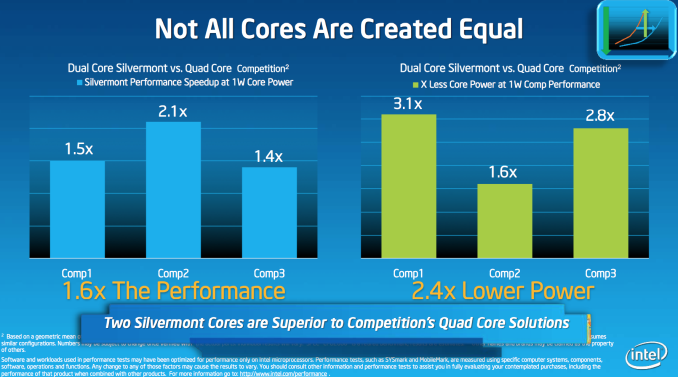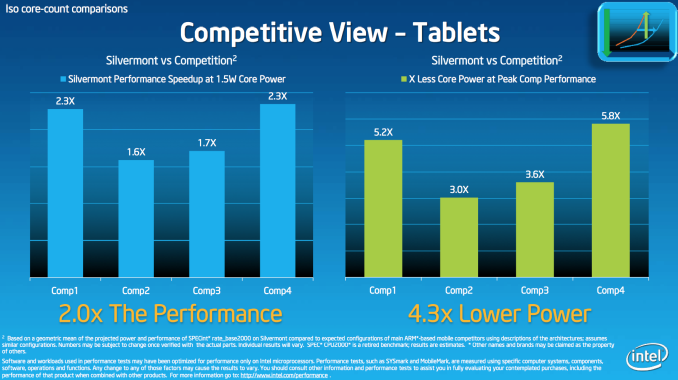Intel’s Silvermont Architecture Revealed: Getting Serious About Mobile
by Anand Lal Shimpi on May 6, 2013 1:00 PM EST- Posted in
- CPUs
- Intel
- Silvermont
- SoCs
Tablet Expectations
Intel is getting architectural details about Silvermont launch ahead of actual SoCs based on the CPU. Baytrail tablets based on Silvermont cores are currently in development and are expected to show up by the end of the year. The Silvermont story at the end of this year should be a lot better than Clovertrail last year. Windows 8 will be in its second major revision (codename Windows Blue) and Intel will launch with both Android and Windows tablet availability. The inclusion of Android is very important to hitting lower price points, something Clovertrail really didn’t have last year. We should see Baytrail based tablets span the gamut of Nexus 7 to iPad pricing, with Haswell picking up where Silvermont ends.
Form factors should be no thicker than Clovertrail based designs, although it will be possible to go thinner with Baytrail/Silvermont should an OEM decide to. Displays should also be a lot better this time around. Intel is working with some OEMs on color calibration, an important step forward as I’m hearing Qualcomm will be doing the same with Snapdragon 800. We’ll also finally see resolutions higher than 1366x768, including potentially some competition for the iPad with Retina Display. Silvermont’s new system agent should do a good job of prioritizing GPU access to main memory in these ultra high resolution scenarios.
Performance
With tablets still months away from being production ready, there’s nothing for us to publicly test. Intel did share some of its own numbers off of its Baytrail reference tablet however, and they are impressive.
All of the Intel comparisons report the geometric mean performance advantage over a spectrum of benchmarks. The benchmarks used include SPECint2K, CoreMark, SunSpider, web page load tests in IE/Chrome/Firefox, Linpack, AnTuTu and Quadrant (ugh) among others. The point here isn’t to demonstrate absolute peak performance in one benchmark, but to instead give us a general idea of the sorts of gains we should expect to see from Silvermont/Baytrail tablets vs the competition. It’s an admirable effort and honestly the right way to do things (short of actually giving us a pre-production tablet to test that is). We’ll start with a comparison to Saltwell, the previous-generation 32nm Atom core. The Saltwell results are listed as STW while Silvermont is abbreviated SLM:
In terms of absolute performance, Silvermont’s peak single threaded performance is 2x that of Saltwell. This 2x gain includes IPC and clock frequency gains (only 50% is from IPC, the rest is due to IDI, system agent and frequency). Given that Saltwell is competitive with existing architectures from ARM and Qualcomm (except for the Cortex A15), a 2x increase in single threaded performance should put Silvermont in a leadership position when it arrives later this year.
The next set of bars is just as important. At the same power levels (Intel didn’t disclose specifically at what power), Silvermont delivers 2x the performance of Saltwell. Finally, at the same performance level, Silvermont uses 4.7x lower power. Given that Saltwell wasn’t terrible on power to begin with, this is very impressive. Without knowing the specific power and performance levels however, I wouldn’t draw too many conclusions based on this data though.
The multithreaded advantages are obviously even greater as Silvermont will be featured in quad-core configurations while Saltwell topped out at dual-core (4 threads) in tablets.
In the next two slides, Intel did some competitive analysis with Silvermont vs. the ARM based competition. The benchmarks are the same, but now we have specifics about power usage. In the first test Intel is comparing to three competitors all with quad-core designs. Intel claims to have estimated performance gains based on what is expected to be in the market by the end of this year. Intel’s performance modeling group is very good at what it does, but as with any estimate you always have to exercise some caution in buying the data until we have physical hardware in hand.
Intel isn’t naming the three competitors in this chart, but there are only a finite number of quad-core ARM players shipping in decent tablet designs these days. The chart on the left compares performance of a dual-core Silvermont to quad-core ARM based designs at a 1W core power level. This comparison is extremely important because it’s effectively demonstrating the type of advantage Intel hopes to have in smartphones next year.
The chart on the right fixes performance and shows the reduction in core power. Do keep in mind that there can be a big difference between core and device level power, although Intel does expect to be very competitive on battery life this round.
The final performance comparison slide increases max core power to 1.5W and compares quad-core Silvermont to the quad-core competition. You’ll note the arrival of a new competitor here. One of the bars is a dual-core SoC with its performance scaled to four cores. I’m less confident about that particular estimation simply because it assumes Apple won’t significantly update architectures in its next generation of iPads.
The performance deltas here are huge. If we assume that at least one of these bars represents a Cortex A15 based design, Silvermont looks very good.
That’s the end of the Intel data, but I have some thoughts to add. First of all, based on what I’ve seen and heard from third parties working on Baytrail designs - the performance claims of being 2x the speed of Clovertrail are valid. Compared to the two Cortex A15 designs I’ve tested (Exynos 5250, dual-core A15 @ 1.7GHz and Exynos 5410 quad-core A15 @ 1.6GHz), quad-core Silvermont also comes out way ahead. Intel’s claims of a 60% performance advantage, at minimum, compared to the quad-core competition seems spot on based on the numbers I’ve seen. Power is the only area that I can’t validate based on what I’ve seen already (no one has given me a Baytrail tablet to measure power on). Given what we know about Silvermont’s architecture and the gains offered by Intel’s 22nm process, I do expect this core to do better on power than what we’ve seen thus far from ARM’s Cortex A15.
There is something we aren’t taking into account though. As of now, the only Cortex A15 based SoCs that we’ve seen have been very leaky designs optimized for high frequency. Should an SoC vendor choose to optimize for power consumption instead, we could see a narrower gap between the power consumption of Cortex A15 and Silvermont. Obviously you give up performance when you do that, so it may not ultimately change anything - but the power story might be less of a blowout.













174 Comments
View All Comments
Amoro - Monday, May 6, 2013 - link
In the first sentence of the paragraph below the Saltwell Vs. Silvermont graph, it states "In terms of absolute performance, Saltwell’s peak single threaded performance is 2x that of Saltwell" and it should be "Silvermont's peak single...."ClockworkPirate - Monday, May 6, 2013 - link
Also at the end of the first paragraph on the "Tablet Expectations and Performance" page, "...with Haswell picking up above Haswell." should probably be "...with Haswell picking up above Bay Trail."chrone - Monday, May 6, 2013 - link
this is the soc i've been waiting for since 2008. winter is coming!! it's gonna be a long winter for arm and friends ahead. \m/theos83 - Monday, May 6, 2013 - link
lol...wait and watch...it has been a long winter for intel (from a mobile market point of view), lets see what they end up with in the next 4 years...ARM and friends are not going away anytime soon.Hector2 - Friday, May 17, 2013 - link
True. The difference between then and now is that Intel didn't have an SoC designed and optimized for smartphones. Now they do (this year) and it'll be about 22nm & 14nm offering Intel higher performance, lower power and lower cost. In this area Intel has about a 2 year lead on their competitionKrysto - Monday, May 6, 2013 - link
It's very, very, VERY hard to beat a monopoly in a certain market (ARM that is), even with a company like Intel that may have a monopoly in another.Plus they have like a dozen competitors there, with at least 3-4 top ones. Intel has promised a lot of stuff before, and under-delivered. So we'll see. ARM chips are also going 20nm and 64 bit next year, and at 14nm FinFET the year after that (yes, only a year later).
Plus, if these things cost 2-3x what the high-end ARM chips cost, they can just pack and go home. No OEM will accept that, unless Intel gives them Haswell in PC's for 30% off, or some deal like that (which would mean they won't be making any money on these Atoms anytime soon).
klmccaughey - Tuesday, May 7, 2013 - link
Intel has the cash to loss-lead on this and open a big crack into the market. It also has the bucks to advertise.My guess is that shareholders are screaming for Intel to get into this market. All the omens look good and I am really looking forward to a big jump in power and battery life for mobiles. I think ARM finally has a real competitor.
HisDivineOrder - Tuesday, May 7, 2013 - link
Intel (and MS) are still under the delusion they're in the 1990's where they could be a premium vendor. Look at all the Windows tablets for proof of this. Intel and MS are both charging way more than they should and all their Wintel tablets (RT or 8) are overpriced by a huge amount.Intel doesn't loss lead. At least, they haven't shown any sign of it at all. Maybe this will be their moment, but somehow... I really, really doubt it.
zeo - Wednesday, May 8, 2013 - link
Don't confuse Intel with the OEMs and MS, Intel isn't over charging on their hardware!The listed Tray cost for the Clover Trail Z2760 SoC is only $41, at a time when ARM high end SoCs are starting to go over $30... So there's not a multiple times cost difference anymore.
OEMs just mistakenly took their cue from MS pricing of the Surface and it's not like the tablet market is really set up for PC configurations.
OEMs for example are used to using internal drive capacity as a way of charging more of their products. Like it doesn't cost anywhere near $50 to double the drive capacity of a Nexus 7 for example or how Apple charges a $100 for each doubling of capacity.
Remember, Windows tablets start with 32GB and that's much higher minimum than what mobile devices still offer.
Along with inclusion of full size USB ports, the added cost of Windows license, the greater tendency to include premium parts like WACOM digitizers, etc all added together for how the pricing finally came out...
However, the OEMs should have learned their lessons, MS is definitely going to offer them better volume license fees this time around, and Bay Trail is suppose to be even lower priced than Clover Trail... So we should see much better pricing with this new generation of products.
BSMonitor - Wednesday, May 8, 2013 - link
Its not a monopoly. There are several companies that build ARM SoC's. ARM is an ISA, no different than x86. If Intel delivers quantity, better performaning SoC's than the competitors, best believe they will switch. Apple already does x86 in house on OS X. Promise you they have been testing Atom in house for potential future designs.. Whether those designs win over ARM A# in house designs is another matter... Intel is nothing if not good at getting companies to sign up with them.. They deliver the highest quality and highest quantities of anyone in the silicon business.